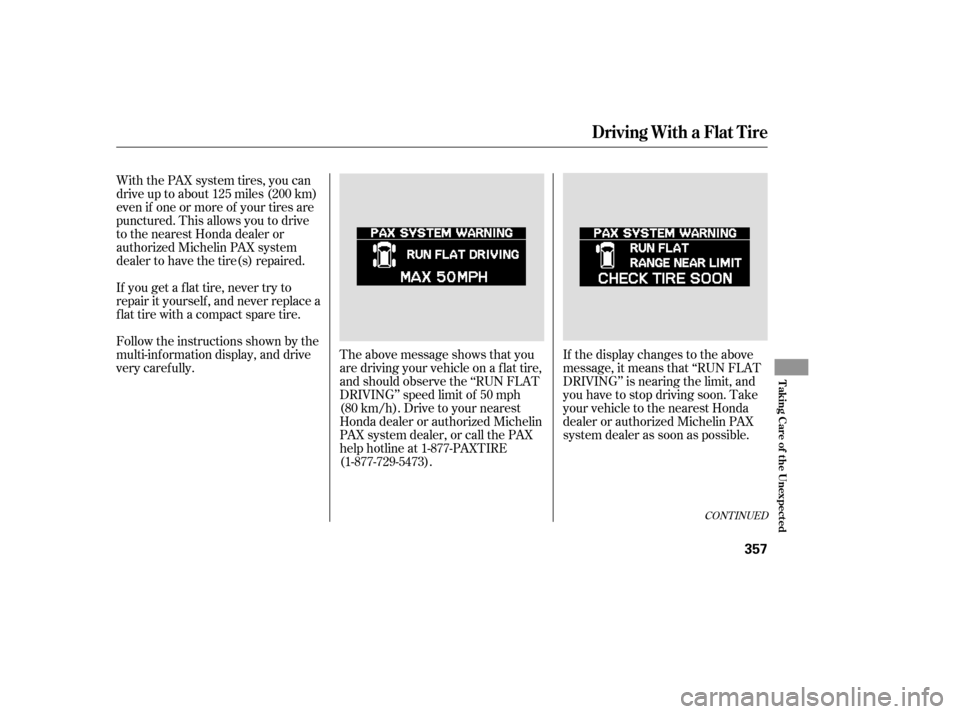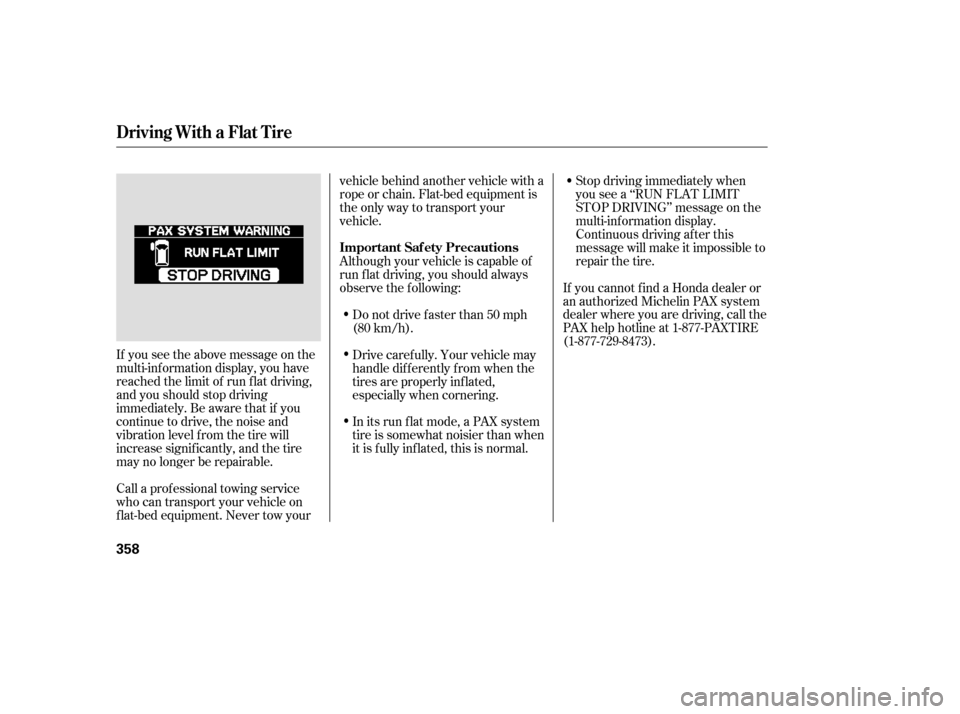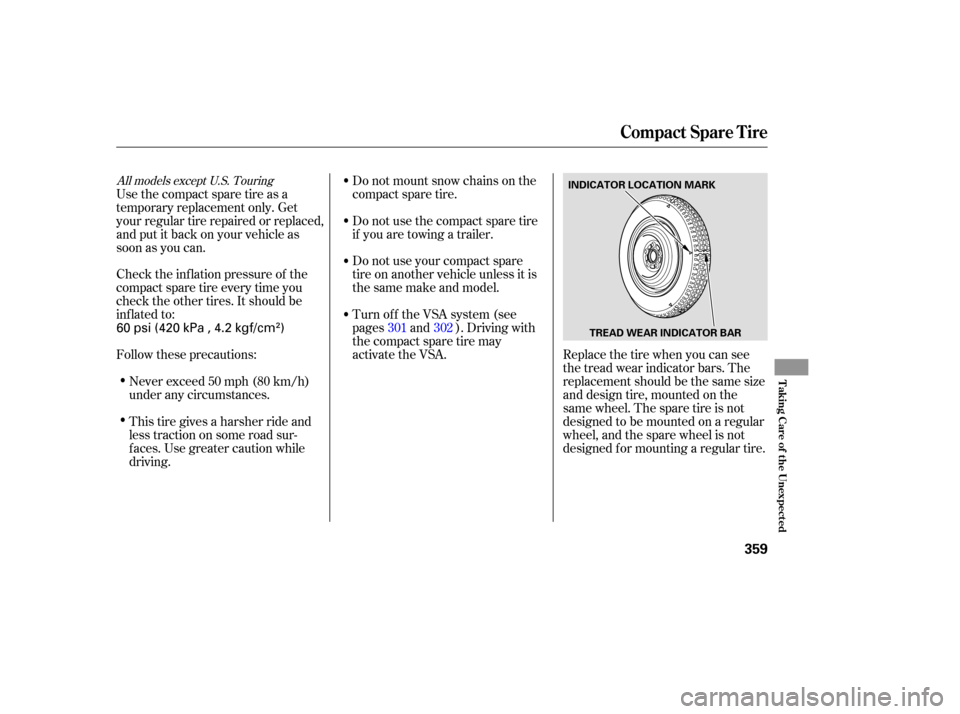Page 358 of 414

With the PAX system tires, you can
drive up to about 125 miles (200 km)
even if one or more of your tires are
punctured. This allows you to drive
to the nearest Honda dealer or
authorized Michelin PAX system
dealer to have the tire(s) repaired.
If you get a f lat tire, never try to
repair it yourself , and never replace a
flat tire with a compact spare tire.The above message shows that you
are driving your vehicle on a flat tire,
andshouldobservethe‘‘RUNFLAT
DRIVING’’ speed limit of 50 mph
(80 km/h). Drive to your nearest
Honda dealer or authorized Michelin
PAX system dealer, or call the PAX
help hotline at 1-877-PAXTIRE
(1-877-729-5473).If the display changes to the above
message, it means that ‘‘RUN FLAT
DRIVING’’ is nearing the limit, and
you have to stop driving soon. Take
your vehicle to the nearest Honda
dealer or authorized Michelin PAX
system dealer as soon as possible.
Follow the instructions shown by the
multi-inf ormation display, and drive
very caref ully.
CONT INUED
Driving With a Flat Tire
T aking Care of t he Unexpect ed
357
Page 359 of 414

If you see the above message on the
multi-inf ormation display, you have
reached the limit of run f lat driving,
and you should stop driving
immediately. Be aware that if you
continue to drive, the noise and
vibration level f rom the tire will
increase signif icantly, and the tire
may no longer be repairable.Stop driving immediately when
you see a ‘‘RUN FLAT LIMIT
STOP DRIVING’’ message on the
multi-inf ormation display.
Continuous driving af ter this
message will make it impossible to
repair the tire.
If you cannot f ind a Honda dealer or
an authorized Michelin PAX system
dealer where you are driving, call the
PAX help hotline at 1-877-PAXTIRE
(1-877-729-8473).
Call a prof essional towing service
who can transport your vehicle on
f lat-bed equipment. Never tow your vehicle behind another vehicle with a
rope or chain. Flat-bed equipment is
the only way to transport your
vehicle.
Do not drive f aster than 50 mph
(80 km/h).
Drive caref ully. Your vehicle may
handle dif f erently f rom when the
tires are properly inf lated,
especially when cornering.
In its run f lat mode, a PAX system
tire is somewhat noisier than when
it is f ully inf lated, this is normal.
Although your vehicle is capable of
runflatdriving,youshouldalways
observe the f ollowing:
Driving With a Flat Tire
Important Saf ety Precautions
358
Page 360 of 414

Replace the tire when you can see
the tread wear indicator bars. The
replacement should be the same size
and design tire, mounted on the
same wheel. The spare tire is not
designed to be mounted on a regular
wheel, and the spare wheel is not
designed f or mounting a regular tire.
Do not mount snow chains on the
compact spare tire.
Turn of f the VSA system (see
pages and ). Driving with
thecompactsparetiremay
activate the VSA. Do not use your compact spare
tire on another vehicle unless it is
thesamemakeandmodel. Do not use the compact spare tire
if you are towing a trailer.
This tire gives a harsher ride and
less traction on some road sur-
f aces. Use greater caution while
driving. Never exceed 50 mph (80 km/h)
under any circumstances.
Follow these precautions: Check the inf lation pressure of the
compact spare tire every time you
check the other tires. It should be
inf lated to: Use the compact spare tire as a
temporary replacement only. Get
your regular tire repaired or replaced,
and put it back on your vehicle as
soon as you can.
301 302
All models except U.S. Touring
Compact Spare T ire
T aking Care of t he Unexpect ed
359
INDICATOR LOCATION MARK
TREAD WEAR INDICATOR BAR
60 psi (420 kPa , 4.2 kgf/cm)
Page 382 of 414

�µ�µ
If your vehicle needs to be towed,
call a prof essional towing service or
organization. Never tow your vehicle
with just a rope or chain. It is very
dangerous.
Therearetwowaystotowyour
vehicle.
The operator
loads your vehicle on the back of a
truck. With the f ront wheels on the ground,
it is best to tow the vehicle no farther
than 50 miles (80 km), and keep the
speedbelow35mph(55km/h).
The tow
truck uses two pivoting arms that go
under the tires (f ront or rear) and lif t
them of f the ground. The other two
tires remain on the ground.
If , due to damage, your vehicle must
be towed with the f ront wheels on
the ground, do the f ollowing:
Release the parking brake.
Start the engine.
ShifttoD,thentoN.
Turn of f the engine.
CONT INUED
Flat bed Equipment Wheel-lif t Equipment
T his is the best way to
transport your vehicle, and it is
only way to transport a Touring
model. T his is
an acceptable way to tow your
vehicleexceptfortheTouring
model.
Emergency T owing
T aking Care of t he Unexpect ed
381
Improper towing preparation will
damage the transmission. Follow the
above procedure exactly. If you cannot
shif t the transmission or start the
engine, your vehicle must be
transported with the f ront wheels of f
the ground.
Page 384 of 414

Thediagramsinthissectiongive
you the dimensions and capacities of
your vehicle, and the locations of the
identif ication numbers. It also
includes inf ormation you should
know about your vehicle’s tires and
emissions control systems.................
Identif ication Numbers . 384
................................
Specif ications .386
DOT Tire Quality Grading .......................
(U.S Vehicles) .388
Unif orm Tire Quality ..................................
Grading .388
.................................
Treadwear .388
......................................
Traction .388
.............................
Temperature .389
.................................
Tire Labeling .390 .......................
Emissions Controls .392
.....................
The Clean Air Act .392
Crankcase Emissions Control ....................................
System .392
Evaporative Emissions Control ....................................
System .392
Onboard Ref ueling Vapor ................................
Recovery .392
...
Exhaust Emissions Controls . 393
....................
PGM-FI System .393
Ignition Timing Control ................................
System .393
Exhaust Gas Recirculation ...................
(EGR) System . 393
Three Way Catalytic ...........................
Converter .393
....................
Replacement Parts . 393
..
Three Way Catalytic Converter . 394
..............
State Emissions Testing . 395
....
Testing of Readiness Codes . 395
T echnical Inf ormat ion
T echnical Inf ormation
383
Page 388 of 414

�µ
�Î
�Î
�Î
�µ
�µ �µ
�µ
�µ
�µ
�µ
�µ
�µ
�µ
�µ
�µ
�µ
�µ
�µ
�µ
�µ
�µ
�µ
�Î
�Î
�Î
Specif ications
T echnical Inf ormation
387
Alignment
Tires Fuses
Battery Lights 60 W (HB3)
12 V
12 V
21 W 51 W (HB4)
21 W
12 V 12 V
Toe-in
Camber
Caster 0.00 in (0.0 mm)
0.08 in (2.0 mm)
0°
0°30’
2°32’
Size
Pressure 235/65R16 103T
235-710R460A 104T T135/80D17 103M
33 psi (230 kPa , 2.3 kgf/cm
)
12 V 35 W
60 psi (420 kPa , 4.2 kgf/cm
)
35 psi (240 kPa , 2.4 kgf/cm)
35 psi (240 kPa , 2.4 kgf/cm)
12 V 12 V
12 V 12 V 12 V
21 W 21/5 W 21 W
12 V
12 V
12 V 2 W 12 V
12 V 1.5 CP
3CP
5W
16 W
5W
5W Interior
Under-hood
See page
379or the fuse label
attached to the dashboard.
See page 380or the fuse label
attached to the inside of the fuse
box door under the dashboard.
See page 378or the fuse box
cover.
Capacity 12 V 12 V72 AH/20 HR
60 AH/5 HR
12 V
12 V
8W
4W(2CP)
Headlights
Front turn signal
Front fog lights
Front turn signal lights
Front parking/side marker
lights
Rear turn signal lights
Stop/Taillights
Taillights
Back-up lights
License plate light
High-mount brake light
Individual map lights
Vanity mirror lights
Cargo area light
Door courtesy light
Front
Rear
Front
Rear
Front
U.S. Touring model Front/Rear
Spare
Front
Rear
Spare
(Amber)
(Amber) Driver’s side
Passenger’s side
1:
2:
3: LX, EX, and Canadian Touring models
EX with Leather and Canadian Touring models
Front
Rear High
Low
1
2
3
Page 389 of 414

�µ
The tires on your car meet all U.S.
Federal Saf ety Requirements. All
tires are also graded for treadwear,
traction, and temperature perform-
ance according to
Department of Transportation
(DOT) standards. The f ollowing
explains these gradings.
Quality grades can be f ound where
applicable on the tire sidewall
between the tread shoulder and the
maximum section width. For
example:
All passenger car tires must conf orm
to Federal Saf ety Requirements in
addition to these grades. The treadwear grade is a compara-
tive rating based on the wear rate of
the tire when tested under controlled
conditions on a specif ied government
test course. For example, a tire
graded 150 would wear one and one-
half (1 1/2) times as well on the
government course as a tire graded
100. The relative perf ormance of
tires depends upon the actual condi-
tions of their use, however, and may
depart signif icantly f rom the norm
due to variations in driving habits,
service practices, and dif f erences in
road characteristics and climate.
The traction grades, f rom highest to
lowest, are AA, A, B, and C. Those
grades represent the tire’s ability to
stop on wet pavement as measured
under controlled conditions on
specif ied government test surf aces
of asphalt and concrete. A tire
marked C may have poor traction
perf ormance.
Warning: The traction grade
assignedtothistireisbasedon
straight-ahead braking traction tests,
and does not include acceleration,
cornering, hydroplaning, or peak
traction characteristics.
DOT T ire Quality Grading (U.S. Vehicles)
Unif orm T ire Quality Grading
T readwear 200
Traction AA
Temperature A Treadwear
Traction AA, A, B, C
388
Page 390 of 414

�µ
The temperature grades are A (the
highest), B, and C, representing the
tire’s resistance to the generation of
heat and its ability to dissipate heat
when tested under controlled
conditions on a specif ied indoor
laboratory test wheel. Sustained high
temperature can cause the material
of the tire to degenerate and reduce
tire life, and excessive temperature
can lead to sudden tire f ailure. The
grade C corresponds to a level of
perf ormance which all passenger car
tires must meet under the Federal
Motor Vehicle Saf ety Standard No.
109. Grades B and A represent
higher levels of perf ormance on the
laboratory test wheel than the
minimum required by law. Warning: The temperature grade f or
this tire is established f or a tire that
is properly inf lated and not over-
loaded. Excessive speed, underinf la-
tion, or excessive loading, either
separately or in combination, can
cause heat buildup and possible tire
f ailure.
DOT T ire Quality Grading (U.S. Vehicles)
Temperature A,B,C
T echnical Inf ormation
389